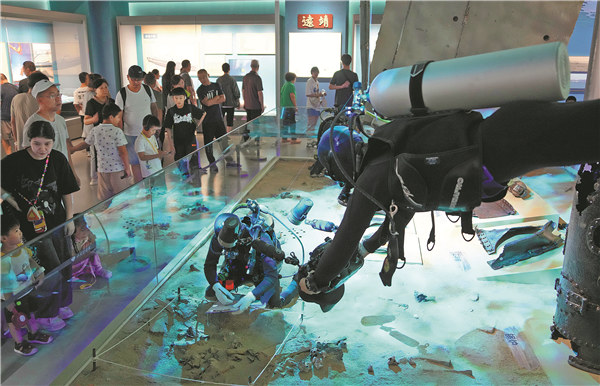
A scene depicting underwater archaeology is re-created for the Bear in Mind the History exhibition. XU SUHUI/XINHUA
Wrecks from naval battles provide a new understanding of historic events, report Zhao Ruixue in Jinan and Wang Kaihao in Beijing.
As Jiang Bo, an esteemed maritime archaeologist, stood before a photo of a large section of a battleship being raised from the sea, he was in a thoughtful mood.
Coincidentally or not, on Sept 17,2020, the anniversary of the Battle of the Yalu River (also known as Battle of the Yellow Sea) — a major naval engagement during the Sino-Japanese War (1894-95) — Jiang and his colleagues brought ashore an 18.7-metric-ton component of the Dingyuan, the ironclad flagship of the Beiyang Fleet during the Qing Dynasty (1644-1911).
"In the enigmatic depths, there always exists a connection," Jiang, director of Maritime Archaeological Research Center of Shandong University, mused while gazing at the photo.
Bear in Mind the History: The Exhibition of the Sino-Japanese Naval War and Underwater Archaeological Findings From the Sunken Warships, an exhibition at the Shandong Museum in Jinan, Shandong province, has put around 330 artifacts excavated from sunken warships on display, and offers visitors deep insight into history, as well as the poignant legacy of the war on its 130th anniversary.
The Beiyang Fleet was China's first modern navy and grew out of the determination of the Qing government to defend national security. From 1875 until the outbreak of the Sino-Japanese War, the government ordered 46 advanced warships from the United Kingdom and Germany, and also built vessels of their own.
Despite this, the Battle of the Yalu River, which took place off the coast of Liaoning province, remains a painful collective memory for generations of Chinese. Five ships were sunk during the fierce battle, at a cost of hundreds of lives.
The Battle of Weihaiwei, off the coast of Weihai in Shandong province, the following year led to another major defeat and annihilation of the fleet, ending the dynasty's dream of turning its destiny around.
Remnants of this history lay deep underwater for over a century. Following the maiden voyage of the country's first vessel designed for underwater research in 2014, Jiang and fellow archaeologists launched a project to find physical evidence of the fleet.
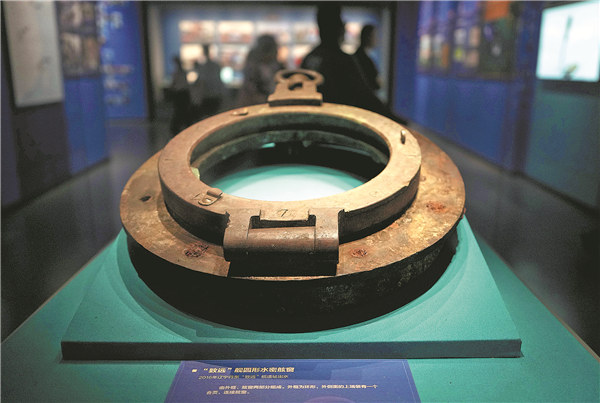
A porthole from the Zhiyuan. [Photo provided to China Daily]
In the past decade, the discovery of seven shipwrecks in the Yellow Sea has yielded a trove of thousands of precious artifacts that bear witness to fallen Chinese sailors, and to a country's strength of spirit. Painstaking study of the Beiyang flagship Dingyuan was probably one of the biggest achievements of the long project.
The Dingyuan was built in Stettin in Germany (today's Szczecin in Poland). It was considered one of the best-equipped battleships of its time.
On Feb 10, 1895, while moored in harbor, the ship was attacked by a Japanese fleet and ran out of ammunition during the Battle of Weihaiwei. It was scuttled by its crew to prevent it from falling into enemy hands.
Following the sinking of the Dingyuan, the Japanese managed to salvage much of the vessel, stripping it of weapons, items of daily use, cables, and coal, taking them to Japan as booty.
"Only the shell of the wreckage remained, settled on the seabed," says Zhou Qiang, a member of the archaeological team from the Shandong Underwater Archaeology Research Center.
Their exploration of the Dingyuan, conducted from 2018 to 2020, revealed a significant cache of small-caliber ammunition rounds. Through the use of sonar equipment, the archaeological team was able to develop a comprehensive understanding of the ship's hull.
The 18.7-ton section lay buried under two to three meters of sediment. In 2020, after nearly two months of meticulous underwater operations, they uncovered the ironclad component, revealing it to be a curved rectangular part of the main gun's protective armor.
In September that year, the team worked with the Guangzhou Salvage Bureau to raise the section from the seabed. On Sept 16, after a full day spent removing sand and securing cables, the remains of the Dingyuan were slowly raised.
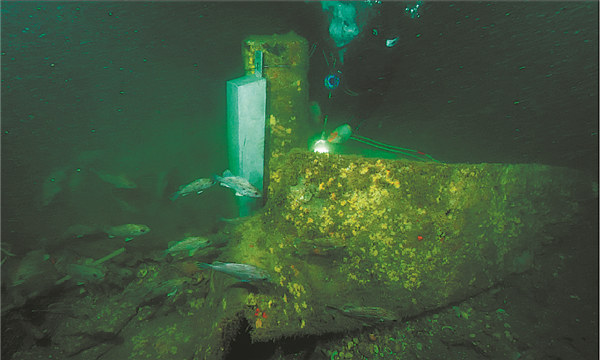
An underwater specialist works on wreckage of the Zhiyuan to preserve it. [Photo provided to China Daily]
As it was about to surface, adverse weather conditions caused one of the two cables to snap. Concerned that lifting the heavy piece with a single cable might result in it slipping, the team decided to temporarily return the artifact to the seabed.
"The following day, with low visibility in Weihai Bay compounded by stirred-up sediment from sand removal, we had to rely solely on tactile senses underwater," Zhou says.
After around 10 hours of dredging, cable threading and hoisting, the piece was finally raised to the salvage vessel.
"As the component was securely placed on the salvage vessel's deck, we erupted into spontaneous applause. The excavated piece is a poignant homage to fallen heroes," he says.
It was this moment that was captured in the photo on exhibition.
In 2022, wreck of the Dingyuan became the first provincial-level protection zone of underwater heritage site in Shandong.
In addition to excavated components, weapons and ammunition, the ongoing exhibition, which will last until the end of October, also displays many of the crew's daily items, including identity tags, porcelain bowls, leather shoes, mahjong tiles, chess pieces, buttons and fragrance bottles, creating a tangible connection to the past. Thanks to them, the cold record of battle is warmed by items of human interest.
Zhou found a bent silver-plated copper spoon by chance during a dive to explore the armored cruiser Laiyuan off the coast near Weihai in 2023, at a time when the ship's identity had not yet been confirmed.
"I couldn't see clearly underwater due to low visibility, and just happened to touch an object that looked like a spoon," he recalls.
Once on land, he saw that it was inscribed with the Chinese characters lai yuan, making it the first artifact from the site to identify the ship.

Exhibits include a sailor's sword from the Laiyuan armored cruiser, excavated off the coast of Weihai, Shandong province. [Photo provided to China Daily]
Two wooden identity tags retrieved from the shipwreck also helped with identification. The tags are now on exhibit after being soaked in saltwater for preservation. One of the tags has the Chinese characters for lai yuan, "third-class sailor", and "Yu Shengyuan", the name of the sailor in question.
The 82-meter armored cruiser was commissioned from Germany by the Qing royal court and was finished in 1887. Other articles discovered in the wreckage of the Laiyuan include Chinese chess sets, leather shoes, a fragrance bottle, porcelain bowls and combs. All are on display.
Some findings may help partly set the record straight. The general public has long suspected that one of the main reasons why the Beiyang Fleet lost the war was that the Qing government refused to provide the funds to update their naval facilities for a number of years.
Documents show that the fleet made a request to add new canons to the Laiyuan. Shell fuses found in the shipwreck confirm that the vessel had been reinforced for conflict.
"The building of the Beiyang Fleet was a crucial attempt to modernize," Jiang says, adding that archaeological research can help clarify what had previously been questioned.
The culmination of 10 years of underwater work has not only refined methodologies for investigating shipwrecks, but also leveraged technologies, such as sonar and 3D modeling.
"The use of marine magnetometers has played an important role in locating shipwrecks," Jiang says.
The artifacts also provide significant physical evidence to researchers studying the history of a range of specialization, including the Beiyang Fleet, the Sino-Japanese War, and the history of East Asia, Jiang adds.
Zhou echoes Jiang's view.
"We plan to summarize and release reports on the seven vessels based on 10 years of underwater archaeological achievements to provide material for fields, such as the study of naval vessels and vessel equipment," he says.
A report on the cruiser Zhiyuan, the first Beiyang ship that was rediscovered from another site in Liaoning province, has been completed and is on show at the exhibition.
"Ships can be an emotional topic," Jiang says. "Through the remains, we see how sailors sacrificed their lives for the country. Historical study involves flesh and blood, as well as a human touch, as it goes into plentiful details."
Liu Chuan contributed to this story.
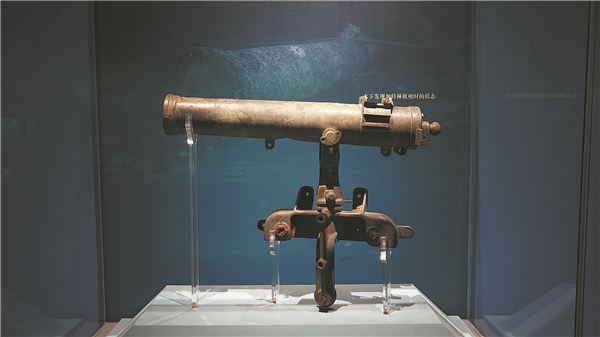
A Gatling gun from the Zhiyuan cruiser, from another site in Liaoning province. [Photo provided to China Daily]
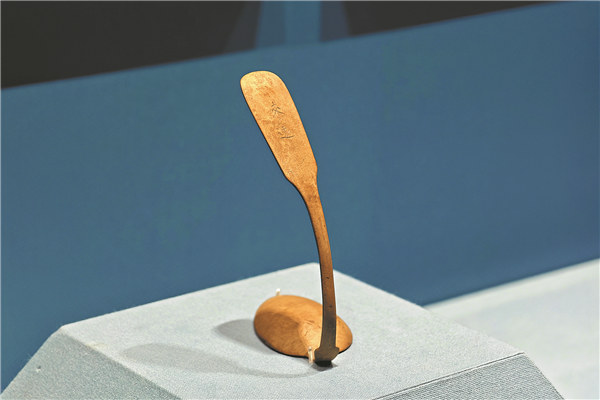
A bent copper spoon carved with the name of Laiyuan. [Photo provided to China Daily]